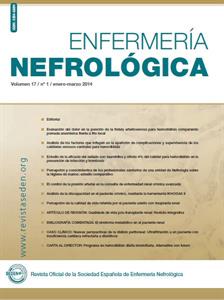Contenido del artículo principal
Resumen
El uso de catéteres centrales ha aumentando de forma importante a pesar de su mayor morbi-mortalidad en comparación con las FAV. Las principales complicaciones son trombosis, bacteriemia-sepsis y limitación de la efi cacia dialítica disminuyendo la calidad de vida de los pacientes y elevando el coste sanitario. En nuestra unidad, el sellado se realizaba con heparina sódica al 5% y actualmente utilizamos TauroLock™- Hep 500®, compuesta de (ciclo)-taurolidina (agente antimicrobiano biocompatible), citrato al 4% y heparina 500 UI/ml. Objetivo: Comprobar la efi cacia del Taurolock para reducir la incidencia de colonización intraluminal y trombosis al compararla con heparina sódica al 5%. Material y método: Realizamos un estudio observacional longitudinal de cohorte y analizamos colonización intraluminal, trombosis, biofilm y uso de antibioterapia. Resultados: Observamos mejoría en la permeabilidad del catéter, disminución del uso de urokinasa, reducción de sesiones en unipunción y del uso de antibiótico. Conclusiones: Nuestro estudio muestra que el sellado del catéter para hemodiálisis con una solución que contiene taurolidina como antimicrobiano puede reducir signifi cativamente la incidencia de sepsis relacionada con el catéter. La taurolidina parece se efectiva y segura y no conlleva riesgos ni efectos secundarios. La adicción de 500 ui de heparina a la solución de sellado junto con citrato al 4% ha disminuido los eventos trombóticos reduciendo el uso de fibrilolíticos y el uso de unipunción totalmente, presentando una mejoría de la efi cacia dialítica.
Palabras clave
Detalles del artículo
Aviso de derechos de autor/a
© Los autores ceden de forma no exclusiva los derechos de explotación de los trabajos publicados y consiente en que su uso y distribución se realice con la Licencia Creative Commons Atribución - No comercial 4.0 Internacional (CC BY-NC 4.0). Puede consultar desde aquí la versión informativa y el texto legal de la licencia. Esta circunstancia ha de hacerse constar expresamente de esta forma cuando sea necesario.




